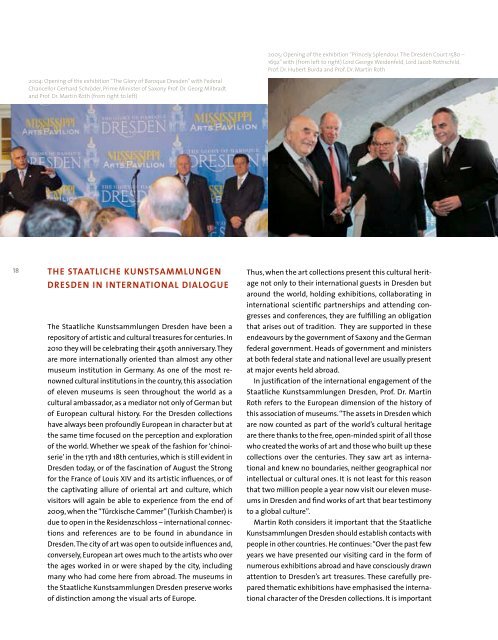2008 - Staatliche Kunstsammlungen Dresden
2008 - Staatliche Kunstsammlungen Dresden
2008 - Staatliche Kunstsammlungen Dresden
You also want an ePaper? Increase the reach of your titles
YUMPU automatically turns print PDFs into web optimized ePapers that Google loves.
2004: Opening of the exhibition “The Glory of Baroque <strong>Dresden</strong>” with Federal<br />
Chancellor Gerhard Schröder, Prime Minister of Saxony Prof. Dr. Georg Milbradt<br />
and Prof. Dr. Martin Roth (from right to left)<br />
18 ThE sTAATLiChE kUNsTsAmmLUNgEN<br />
DREsDEN iN iNTERNATiONAL DiALOgUE<br />
The <strong>Staatliche</strong> <strong>Kunstsammlungen</strong> <strong>Dresden</strong> have been a<br />
repository of artistic and cultural treasures for centuries. In<br />
2010 they will be celebrating their 450th anniversary. They<br />
are more internationally oriented than almost any other<br />
museum institution in Germany. As one of the most renowned<br />
cultural institutions in the country, this association<br />
of eleven museums is seen throughout the world as a<br />
cultural ambassador, as a mediator not only of German but<br />
of European cultural history. For the <strong>Dresden</strong> collections<br />
have always been profoundly European in character but at<br />
the same time focused on the perception and exploration<br />
of the world. Whether we speak of the fashion for ‘chinoiserie’<br />
in the 17th and 18th centuries, which is still evident in<br />
<strong>Dresden</strong> today, or of the fascination of August the Strong<br />
for the France of Louis XIV and its artistic influences, or of<br />
the captivating allure of oriental art and culture, which<br />
visitors will again be able to experience from the end of<br />
2009, when the “Türckische Cammer” (Turkish Chamber) is<br />
due to open in the Residenzschloss – international connections<br />
and references are to be found in abundance in<br />
<strong>Dresden</strong>. The city of art was open to outside influences and,<br />
conversely, European art owes much to the artists who over<br />
the ages worked in or were shaped by the city, including<br />
many who had come here from abroad. The museums in<br />
the <strong>Staatliche</strong> <strong>Kunstsammlungen</strong> <strong>Dresden</strong> preserve works<br />
of distinction among the visual arts of Europe.<br />
2005: Opening of the exhibition “Princely Splendour. The <strong>Dresden</strong> Court 1580 –<br />
1692” with (from left to right) Lord George Weidenfeld, Lord Jacob Rothschild,<br />
Prof. Dr. Hubert Burda and Prof. Dr. Martin Roth<br />
Thus, when the art collections present this cultural heritage<br />
not only to their international guests in <strong>Dresden</strong> but<br />
around the world, holding exhibitions, collaborating in<br />
international scientific partnerships and attending congresses<br />
and conferences, they are fulfilling an obligation<br />
that arises out of tradition. They are supported in these<br />
endeavours by the government of Saxony and the German<br />
federal government. Heads of government and ministers<br />
at both federal state and national level are usually present<br />
at major events held abroad.<br />
In justification of the international engagement of the<br />
<strong>Staatliche</strong> <strong>Kunstsammlungen</strong> <strong>Dresden</strong>, Prof. Dr. Martin<br />
Roth refers to the European dimension of the history of<br />
this association of museums. “The assets in <strong>Dresden</strong> which<br />
are now counted as part of the world’s cultural heritage<br />
are there thanks to the free, open-minded spirit of all those<br />
who created the works of art and those who built up these<br />
collections over the centuries. They saw art as international<br />
and knew no boundaries, neither geographical nor<br />
intellectual or cultural ones. It is not least for this reason<br />
that two million people a year now visit our eleven museums<br />
in <strong>Dresden</strong> and find works of art that bear testimony<br />
to a global culture”.<br />
Martin Roth considers it important that the <strong>Staatliche</strong><br />
<strong>Kunstsammlungen</strong> <strong>Dresden</strong> should establish contacts with<br />
people in other countries. He continues: “Over the past few<br />
years we have presented our visiting card in the form of<br />
numerous exhibitions abroad and have consciously drawn<br />
attention to <strong>Dresden</strong>’s art treasures. These carefully prepared<br />
thematic exhibitions have emphasised the international<br />
character of the <strong>Dresden</strong> collections. It is important

















